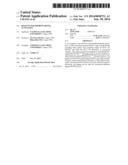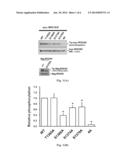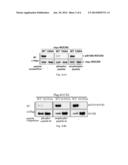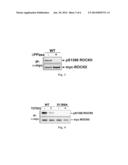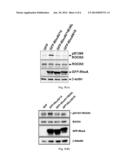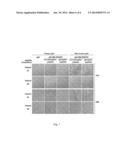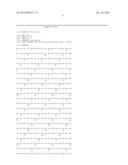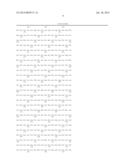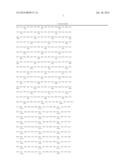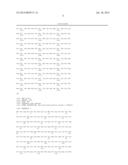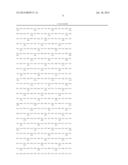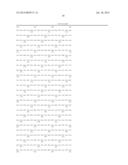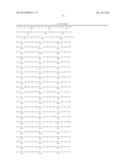Patent application title: REGENTS FOR PROBING ROCKS ACTIVATION
Inventors:
Zee-Fen Chang (Taipei, TW)
Hsiao-Hui Lee (Taipei, TW)
Assignees:
NATIONAL YANG-MING UNIVERSITY
IPC8 Class: AC07K1640FI
USPC Class:
435 71
Class name: Chemistry: molecular biology and microbiology measuring or testing process involving enzymes or micro-organisms; composition or test strip therefore; processes of forming such composition or test strip involving antigen-antibody binding, specific binding protein assay or specific ligand-receptor binding assay
Publication date: 2014-01-30
Patent application number: 20140030731
Abstract:
A set of agents is provided for probing/detecting the activation of
Rho-associated protein kinase I and II individually encoding their amino
acid sequence (SEQ ID NO:1 for ROCKI and SEQ ID NO:2 for ROCKII) in
biological samples. The agents include one antibody to specifically
recognize ROCKI Ser1333 phosphorylation and one antibody to
specifically recognize ROCKII Ser1366 phosphorylation. The agents
can be used for pathological analysis in cardiovascular diseases, cancer,
neurological diseases or other diseases/disorders involving ROCKs and
also for basic medical research. Moreover, the agents can be used for
screening inhibitors against ROCKI and II.Claims:
1. A reagent for probing the activation of a Rho-associated protein
kinase II (ROCKII) in a biological sample, the ROCKII encoded with a
peptide-II sequence, wherein the reagent comprises an antibody-II for
recognizing a serine 1366 phosphorylation on the peptide-II sequence.
2. The reagent according to claim 1, wherein the peptide-II sequence has an oligopeptide sequence of DPFARSSPRTSMK from an N-terminal to a C-terminal.
3. The reagent according to claim 2, wherein a third serine numbered from the N-terminal of the oligopeptide sequence is phosphorylated.
4. The reagent according to claim 1, wherein the biological sample is originated from a subject being subjected to or suspected to be subjected to a disease, and the disease is selected from a group consisting of liver tumor, breast cancer, leukemia, melanoma, prostate cancer, lung cancer, cardiovascular diseases, neurological diseases and a combination thereof.
5. The reagent according to claim 4, wherein the subject is a human or a mammal excluding the human.
6. The reagent according to claim 1, wherein the reagent further comprises an oligopeptide-IIa with a sequence of N'-DPFARSSPRTSMK-C' and an oligopeptide-IIb with a sequence of N'-DPFARSSPRTpSMK-C'.
7. The reagent according to claim 1, wherein the peptide-II sequence is SEQ ID NO:2.
8. An antibody-II for recognizing a Rho-associated protein kinase II (ROCKII) having a peptide-II sequence, wherein the antibody-II is capable of recognizing a serine 1366 phosphorylation on the peptide-II sequence.
9. The antibody-II according to claim 8, wherein the antibody-II comprises two antigen binding regions, each of which is capable of recognizing the serine 1366 phosphorylation on the peptide-II sequence.
10. A method for probing the activation of a Rho-associated protein kinase II (ROCKII) in a biological sample, the ROCKII having a peptide-II sequence with a serine 1366 phosphorylation, the method comprising: (a) providing an antibody-II capable of recognizing the serine 1366 phosphorylation on the ROCKII and an oligopeptide-IIa encoding a sequence of N'-DPFARSSPRTSMK-C'; (b) mixing the antibody-II and the oligopeptide-IIa as a second mixture; and (c) adding the second mixture to the biological sample, wherein the ROCKII is activated in the biological sample when a positive signal is generated, and the ROCKII is not activated therein when a negative signal is generated.
11. The method according to claim 10, wherein the step (a) further comprises: (a1) providing an oligopeptide-IIb encoding a sequence of N'-DPFARSSPRTpSMK-C'; (a2) mixing the antibody-II and the oligopeptide-IIb as a fourth mixture; and (a3) adding the fourth mixture to the biological sample to determine as the negative signal as a negative control of the method.
12. The method according to claim 10 being applicable to evaluate an enzymatic activity of the ROCKII or a drug screening for a specific ROCKII inhibitor.
13. A reagent for probing the activation of a Rho-associated protein kinase I (ROCKI) in a biological sample, the ROCKI encoded with a peptide-I sequence, wherein the reagent comprises an antibody-I for recognizing a serine 1333 phosphorylation on the peptide-I sequence.
14. The reagent according to claim 13, wherein the peptide-I sequence has an oligopeptide sequence of RASPRTLSTRS from an N-terminal to a C-terminal.
15. The reagent according to claim 14, wherein a second serine numbered from the N-terminal of the oligopeptide sequence is phosphorylated.
16. The reagent according to claim 13, wherein the biological sample is originated from a subject being subjected to or suspected to be subjected to a disease, and the disease is selected from a group consisting of liver tumor, breast cancer, leukemia, melanoma, prostate cancer, lung cancer, cardiovascular diseases, neurological diseases and a combination thereof.
17. The reagent according to claim 16, wherein the subject is a human, a mammal excluding the human, or a cell thereof.
18. The reagent according to claim 13, wherein the reagent further comprises an oligopeptide-Ia with a sequence of N'-RASPRTLSTRS-C' and an oligopeptide-Ib with a sequence of N'-RASPRTLpSTRS-C'.
19. The reagent according to claim 13, wherein the peptide-I sequence is SEQ ID NO:1.
20. An antibody-I for recognizing a Rho-associated protein kinase I (ROCKI) having a peptide-I sequence, wherein the antibody-I is capable of recognizing a serine 1333 phosphorylation on the peptide-I sequence.
21. The antibody-I according to claim 20, wherein the antibody-I comprises two antigen binding regions, each of which is capable of recognizing the serine 1333 phosphorylation on the peptide-I sequence.
22. A method for probing the activation of a Rho-associated protein kinase I (ROCKI) in a biological sample, the ROCKI having a peptide-I sequence with a serine 1333 phosphorylation, the method comprising: (a) providing an antibody-I capable of recognizing the serine 1333 phosphorylation on the ROCKI and an oligopeptide-Ia encoding a sequence of N'-RASPRTLSTRS-C'; (b) mixing the antibody-I and the oligopeptide-Ia as a first mixture; and (c) adding the first mixture to the biological sample, wherein the ROCKI is activated in the biological sample when a positive signal is generated, and the ROCKI is not activated therein when the negative signal is generated.
23. The method according to claim 22, wherein the step (a) further comprises: (a1) providing an oligopeptide-Ib encoding a sequence of N'-RASPRTLpSTRS-C'; (a2) mixing the antibody-I and the oligopeptide-Ib as a third mixture; and (a3) adding the third mixture to the biological sample to determine as a negative signal as a negative control of the method.
24. The method according to claim 22 being applicable to evaluate an enzymatic activity of the ROCKI or a drug screening for a specific ROCKI inhibitor.
Description:
CROSS-REFERENCE TO RELATED APPLICATIONS
[0001] This Non-provisional application claims priority under 35 U.S.C. §119(a) on Patent Application No(s). 101126665 filed in Taiwan, Republic of China Jul. 24, 2012, the entire contents of which are hereby incorporated by reference.
FIELD OF THE INVENTION
[0002] This invention relates to a detection reagent kit, in particularly, this invention relates to a reagent kit capable of probing the activations of ROCKI and ROCKII individually.
BACKGROUND OF THE INVENTION
[0003] Rho-associated protein kinases (ROCKs), the downstream effectors of Rho A, belong to the member of a serine/threonine protein kinase family. This molecule play key roles in many cellular processes, including the regulation of cell adhesion, migration, contractility, growth, apoptosis, centrosome duplication, and cytokinesis. ROCKs also play the key role in the occurrence of cardiovascular diseases, cancer and neurological diseases. Two ROCK isoforms, have been identified in mammals, ROCKI and ROCKII. They have the similar domain structure and composed of a kinase domain in the N-terminus, a RhoA-binding domain and a pleckstrin homology (PH) domain in the C-terminal region. The signaling pathways for regulating ROCK activity in cells includes: (1) the combination of RhoA and ROCK, (2) proteolytic cleavage of the C-terminal inhibitory domain in apoptotic cells, (3) the intracellular second messengers, such as arachidonic acid, or (4) the interaction with several proteins, such as stimulation by polo-like kinase-1 (Plk1) and nucleophosmin, and repression by GTP binding protein (Gem and Rad, for instance) and the ROCK inhibitor (Morgana).
[0004] Recently, the methods for detecting the ROCK activation including: (1) to indirectly determine ROCK phosphorylation by measuring the inhibitor-sensitive phosphorylation ROCK downstream subtracts (e.g. myosin light chain (MLC), myosin binding substrate (MBS), LIM kinase (LIMK), and α-adducin); or (2) to measure the catalytic activity of the purified ROCK kinase by in vitro kinase assay. However, the phosphorylation levels of ROCK downstream subtracts do not directly correspond to the respective activations of ROCKI or ROCKII in cells and tissues. And the ROCK kinase in vitro kinase assay requires high amount of purified ROCK protein that is unfavorable for detecting ROCK activity in cells and tissues. In addition, the loss of RhoA binding during sample preparation might result in the disadvantage of assay. There is no any method can directly and efficiently measure the respective activation of ROCKI and ROCKII. Therefore, these traditional methods are not sufficient to determine ROCKI and ROCKII activation in tissues to evaluate the relationship between the ROCKs activation and diseases such as cardiovascular diseases, cancer or neurological diseases.
[0005] It is therefore attempted by the applicant to deal with the above situation encountered in the prior art.
SUMMARY OF THE INVENTION
[0006] There are two ROCKs, ROCKI and ROCKII, in mammals. In our studies, We found that these two protein kinases are autophosphorylated upon activation. In order to find the method and tool for determining the activation of ROCKI and ROCKII directly and efficiently, we identified the phosphorylation sites in ROCKI and ROCKII individually and demonstrated that those phosphorylation indeed reflect to their activation. The present invention discloses a pair of specific antibodies those against the ROCKI and ROCKII phosphorylation individually and are used to evaluate the activation levels of ROCKI and ROCKII respectively. These antibodies can be further prepared as the detection kits, and thus the reagents can be applied for the detection of the ROCKI and ROCKII activation in the biological samples. The results will provide information for the reference to the pathological analysis of diseases for clinics and the clinically therapeutic administration. The detection reagent also can be applied in the relevant researches for the drug screening of ROCKI and ROCKII specific inhibitors.
[0007] Therefore, the present invention provides a kit for probing the activation of Rho-associated protein kinases (ROCKs) including ROCKI and ROCKII individually in the biological samples, wherein the kit includes an antibody-I for recognizing phosphorylated serine 1333 (pSer1333) in the ROCKI peptide sequence (SEQ ID NO:1), an antibody-II for recognizing phosphorylated serine 1366 (pSer1366) in the ROCKII peptide sequence (SEQ ID NO:2), a synthetic unphosphorylated peptide (oligopeptide-Ia) with the peptide sequence corresponding to antibody-I and a synthetic phosphorylated peptide (oligopeptide-Ib) with the same peptide sequence, and a synthetic unphosphorylated peptide (oligopeptide-IIa) with the peptide sequence corresponding to antibody-II and a synthetic phosphorylated peptide (oligopeptide-IIb) with the same peptide sequence.
[0008] Preferably, oligopeptide-Ia is a synthetic oligopeptide including the amino acid (a.a.) residues 1326 to 1336 of ROCKI (SEQ ID NO: 1), and has an amino acid sequence of N'-RASPRASPRTLSTRS-C'. Oligopeptide-Ib is a synthetic oligopeptide which has the same sequence as oligopeptide-Ia but the second serine is phosphorylated; therefor, the oligopeptide-Ib has an amino acid sequence of N'-RASPRTLpSTRS-C'. Oligopeptide-IIa is a synthetic oligopeptide including the amino acid residues 1356 to 1368 of ROCKII (SEQ ID NO: 2), and has the same sequence as oligopeptide-Ia but the third serine is phosphorylated; therefor, theoligopeptide-IIb has an amino acid sequence of N'-DPFARSSPRTpSMK-C'.
[0009] Oligopeptide-Ib acts as the antigen to immunize animals, so that the phospho-specific antibody-I is generated and purified to recognize Ser1333 phosphorylation of ROCKI that indicates the activation of ROCKI kinase activity. Oligopeptide-IIb acts as the antigen to immunize animals, so that the phospho-specific antibody-II is generated and purified to recognize Ser1366 phosphorylation of ROCKII that indicates the activation of ROCKII kinase activity. Using antibody-I and antibody-II to probe the biological samples, protein extracts from cells or tissue could be analyzed by Western blotting; the fixed cells or tissue sections could be probe by immunohistochemical staining. At the same time, the phosphorylated peptides (oligopeptide-Ib and oligopeptide-IIb) and the unphosphorylated peptides (oligopeptide-Ia and oligopeptide-IIa) are used to proceed the antibody neutralization to identify those signals are indeed reflect to the phosphorylation of ROCKI and ROCKII individually, so as to further analyze the respective phosphorylation levels of ROCKI and ROCKII in the biological samples. The reaction performed by the addition of the phosphorylated peptide and the antibody acts as the negative control. If the signal of the antibody reaction is positive in the present of unphosphorylated peptide, it refers to that the molecules (ROCKI and ROCKII) are activated, and the signal intensities are proportional to the levels of kinase activities. Otherwise, if the signal is negative or the intensity is equal with the signal in negative control reaction, the molecules (ROCKI and ROCKII) are not activated.
[0010] The above biological samples are originated from a subject being subjected to or suspected to be subjected to a disease, and the disease may be but is not limited to liver tumor, breast cancer, leukemia, melanoma, prostate cancer, lung cancer, cardiovascular diseases and/or neurological diseases. Additionally, the subject is a human or other mammals, and the biological samples are cellular or tissue samples.
[0011] The above reagents includes an antibody-I for recognizing Ser1333 phosphorylation of ROCKI, an antibody-II for recognizing Ser1366 phosphorylation of ROCKII, a synthetic oligopeptide-Ia including a peptide sequence of N'-RASPRTLSTRS-C', a synthetic oligopeptide-Ib including a peptide sequence of N'-RASPRTLpSTRS-C', a synthetic oligopeptide-IIa including a peptide sequence of N'-DPFARSSPRTSMK-C', and a synthetic oligopeptide-IIb including a peptide sequence of N'-DPFARSSPRTpSMK-C'. Each of antibody-I and -II and oligopeptide-Ia, -Ib, -IIa and -IIb in the reagent has a lowest effective amount to represent their function and effect. For Western blotting, the amount of antibody is used about 0.5 μg/ml to 2 μg/ml, and the amount of oligopeptide is used about 0.1 μg/ml to 1 μg/ml. For immunohistochemical staining, the amount of antibody is used about 2 μg/ml to 5 μg/ml, and oligopeptide is used about 0.4 μg/ml to 2.5 μg/ml.
[0012] The present invention further provides two antibodies for recognizing ROCKI or ROCKII, respectively. ROCKI is encoded with a peptide-I sequence (SEQ ID NO:1), wherein antibody-I is capable of recognizing Ser1333 phosphorylation of peptide-I sequence. ROCKII is encoded with a peptide-II sequence (SEQ ID NO:2), wherein antibody-II is capable of recognizing Ser1366 phosphorylation of peptide-II sequence.
[0013] Preferably, the antibody includes two antigen binding domains, each of which is composed of a light chain variable (VL) domain and a heavy chain variable (VH) domain. The antigen binding domains of antibody-I can recognize Ser1333 phosphorylation of ROCKI, and those of antibody-II can recognize Ser1366 phosphorylation of ROCKII.
[0014] The present invention further provides a method for probing ROCKI activation or ROCKII activation in a biological sample. ROCKI has a peptide-I sequence (SEQ ID NO:1) with Ser1333 residue, and ROCKII has a peptide-II sequence (SEQ ID NO:2) with Ser1366 residue. The method includes: (1) providing an antibody-I capable of recognizing Ser1333 phosphorylation of ROCKI and an oligopeptide-Ia encoding a sequence of N'-RASPRTLSTRS-C'; mixing the antibody-I and the oligopeptide-Ia as a first mixture; and adding the first mixture to the biological sample, wherein ROCKI is activated in the biological sample and the signal intensity indicates to the kinase level of ROCKI when a positive signal is generated; and ROCKI is not activated therein when the negative signal is generated; and (2) providing an antibody-II capable of recognizing Ser1366 phosphorylation of ROCKII and an oligopeptide-IIa encoding a sequence of N'-DPFARSSPRTSMK-C'; mixing the antibody-II and the oligopeptide-IIa as a second mixture; and adding the second mixture to the biological sample, wherein ROCKII is activated in the biological sample and the signal intensity indicates to the kinase level of ROCKII when a positive signal is generated; and ROCKII is not activated therein when a negative signal is generated.
[0015] The method (1) further includes: (3) providing an oligopeptide-Ib encoding a sequence of N'-RASPRTLpSTRS-C'; mixing the antibody-I and the oligopeptide-Ib as a third mixture; and adding the third mixture to the biological sample. Since the second serine numbered from the N-terminus of oligopeptide-Ib is phosphorylated, oligopeptide-Ib may be conjugated with the antibody to neutralize the antibody, such that antibody-I cannot recognize the activated ROCKI in the biological sample and thus the result is determined as the negative signal. The method (2) further includes: (4) providing an oligopeptide-IIb encoding a sequence of N'-DPFARSSPRTpSMK-C'; mixing the antibody-II and the oligopeptide-IIb as a fourth mixture; and adding the fourth mixture to the biological sample. Since the third serine numbered from the N-terminus of oligopeptide-IIb is phosphorylated, oligopeptide-IIb may be conjugated with the antibody to neutralize the antibody, such that antibody-II cannot recognize the activated ROCKII in the biological sample and thus the result is determined as the negative signal. The results of the methods (3) and (4) are the negative control for the detection method of the present invention.
[0016] The present invention further provides a method for detecting the catalytic activity of ROCKI and ROCKII. ROCKI has a peptide-I sequence (SEQ ID NO:1) with Ser1333 residue, and ROCKII has a peptide-II sequence (SEQ ID NO:2) with Ser1366 residue. The method can be used to screen the specific ROCKI and ROCKII inhibitors by determining the inhibitory effect of the drugs on the catalytic activity of ROCKI and ROCKII, respectively.
[0017] The detailed technologies and the preferred embodiments of the present invention will be described in the following contents for one skilled in the art to appreciate the features of the present invention.
BRIEF DESCRIPTION OF THE DRAWINGS
[0018] The patent or application file contains at least one drawing executed in color. Copies of this patent or patent application publication with color drawing(s) will be provided by the Office upon request and payment of the necessary fee.
[0019] FIG. 1(A) illustrates the isotope-labeled autoradiography showing the in vitro kinase reaction after the wild-type (WT) myc-ROCKII and its mutant and the WT flag-ROCKI and its mutant are expressed in HEK-293T cells.
[0020] FIG. 1(B) illustrates the bar chart of relative phosphorylation of myc-ROCKII WT and its mutant.
[0021] FIG. 2(A) illustrates the Western blotting pattern showing anti-pSer1366 ROCKII antibody-II against the phosphorylated ROCKII. myc-ROCKII protein is obtained with extraction after the WT or S1366A mutant myc-ROCKII expression constructs are respectively transfected into HEK-293T cells and immunoprecipitated using anti-myc antibody, and Ser1366 phosphorylation of myc-ROCKII is probed with antibody-II (1 μg/ml) with or without the competition of phosphorylated peptide-IIa (0.2 μg/ml).
[0022] FIG. 2(B) illustrates the Western blotting pattern showing anti-pSer1333 ROCKI antibody-I against the phosphorylated ROCKI flag-ROCKI protein is obtained with extraction after the WT or S1333A mutant flag-ROCKI expression constructs are respectively transfected to HEK-293T cells and immunoprecipitated using anti-flag antibody, and Ser1333 phosphorylation of flag-ROCKI is probed with antibody-I (1 μg/ml) with or without the competition of phosphorylated peptide-Ia (0.2 μg/ml).
[0023] FIG. 3 illustrates the Western blotting pattern showing the signal of immunoprecipitated WT myc-ROCKII with or without λ protein phosphatase (λPPase) at 30° C. for 20 minutes treatment probed with antibody-II
[0024] FIG. 4 illustrates the Western blotting pattern showing the signal of immunoprecipitated WT or S1366A myc-ROCKII expressed in HEK293T cells which were treated with or without Y27632 (20 μM) for 2 hours before harvested for IP and probing with antibody-II.
[0025] FIGS. 5(A) and 5(B) respectively illustrate the Western blotting patterns showing (A) antibody-I and (B) antibody-II against the protein extract of the HEK-293T cells expressed GFP, GFP-RhoAV 14, GFP-RhoAV 14E40L or GFP-RhoAV19.
[0026] FIGS. 6(A) and 6(B) respectively illustrate the Western blotting patterns showing (A) antibody-I and (B) antibody-II against the protein extract from normal mouse embryonic fibroblasts (MEFs) stimulated with nocodazole (10 μM) in present or absent of Y27632 (10 μM).
[0027] FIG. 7 illustrates the immunohistochemistry images showing RCOKII Ser1366 phosphorylation in human breast tumor tissues. The tumor part and non-tumor part breast tissues of from two breast cancer patients are sectioned, and probed with anti-pSer1366 ROCKII antibody in the presence of phosphorylated peptide-IIb and unphosphorylated peptide-IIa. The normal rabbit IgG is the control for negative reaction, and #1 is negative for lymph node and #2 is positive for lymph node.
DETAILED DESCRIPTION OF THE INVENTION
[0028] For clarity of disclosure, and not by way of limitation, the detailed description of the invention is divided into the subsections that follow.
[0029] Experimental Methods:
[0030] The various gene constructs were formed by using QuikChange® Site-Directed Mutagenesis Kit (Stratagene) to individually introduce the specific mutations to the wild-type (WT) pEF-myc-ROCKII (6-1388) (from K. Kaibuchi; Nara Institute of Science and Technology, Ikoma, Japan) or pCMV2-flag-ROCKI plasmid.
[0031] I. Immunoprecipitation and In Vitro Kinase Reaction:
[0032] myc-ROCKII-expressing cells were harvested in an immunoprecipitation (IP) buffer (1% NP-40, 5% glycerol, 50 mM Tris/HCl, pH 7.4, 150 mM NaCl, 1 mM PMSF (phenylmethylsulfonyl fluoride), and protease inhibitor cocktail). The lysates after pre-clearance were incubated with anti-myc antibody at 4° C. for 60 minutes, and then precipitated with protein A-agarose beads for 30 minutes. The immunoprecipitates were preincubated with or without 100 μM of Y27632 (ROCK inhibitor), which was followed by incubation with a 1X kinase buffer (50 mM Tris/HCl, pH 7.4, 10 mM MgCl2, 1 mM EGTA (ethylene glycol tetraacetic acid), 0.5 mM DTT (dithiothreitol), 5 mM NaF, and 0.1 mM Na3VO4, 20 μM ATP) containing 5 μCi of [γ-32]ATP at 30° C. for 20 minutes. The immunoprecipitates (controls) from non-transfected cells were used backgrounds. The protein level of myc-ROCKII was detected by Western blotting with anti-myc antibody known by the skilled person in the art. The protein level of flag-ROCKI was probed using the similar immunoprecipitation and Western blotting with anti-flag antibody.
[0033] II. In-Gel Digestion and LC-MS/MS:
[0034] The protein band corresponding to myc-ROCKII was excised from the gel for protease digestion as described by Tsay et al. (Anal. Biochem. 2000. 287: 55-64). In brief, proteins were digested with Lys-C, Arg-C and Asp-N (the multiple enzymes used to increase sequence coverage), and the peptides were extracted with 0.1% formic acid. Electrospray ionization-ion trap tandem mass spectrometry was performed using a Thermo Finnigan LTQ Orbitrap tandem mass spectrometer interfaced with an Agilent 1100D HPLC system. The spectra for elute was acquired as successive sets of scan modes described by Tsay et al. (Anal. Biochem. 2000. 287: 55-64), which included (1) identification of phosphopeptides on selected ion tracings based on their elution behavior, (2) mapping phosphorylated amino acids within the sequence by collision-induced dissociation (CID) experiments, and (3) using the selected ion tracing method to quantitatively determine the phosphorylation states of myc-ROCKII proteins.
[0035] III. Phospho-Specific Antibody Generation:
[0036] The specific polyclonal anti-pSer1333 ROCKI antibody was raised using the phosphopeptide-Ib containing pSer1333 of ROCKI conjugated with keyhole limpet haemocyanin (KLH) as an antigen to immune rabbits. The anti-sera were collected and sequentially affinity-purified by the phosphopeptide- and the non-phosphopeptide-conjugated columns to remove the non-anti-phosphorylation antibody. The anti-sera were desalted and concentrated to obtain the specific polyclonal anti-pSer1333 ROCKI antibody (antibody-I). The specific polyclonal anti-Ser1366 ROCKII antibody was raised using the phosphopeptide-IIb containing pSer1366 of ROCKII conjugated with KLH as an antigen to immunize rabbits. The anti-sera were collected and sequentially affinity-purified by the phosphopeptide- and the non-phosphopeptide-conjugated columns to remove the non-anti-phosphorylation antibody. The anti-sera were desalted and concentrated to obtain the specific polyclonal anti-pSer1366 ROCKII antibody (antibody-II).
[0037] IV. Immunohistochemical (IHC) Staining:
[0038] The tumor part and the non-tumor part of the breast tissue blocks were embedded in Tissue-Tek OCT® compound, snap-frozen, and sectioned into 5 μm cryosections. The sections were fixed with 4% (w/v) paraformaldehyde for 15 minutes and placed in boiling citrate buffer for 10 minutes. Endogenous peroxidase activity was quenched by 3% hydrogenous peroxidase for 10 minutes and this was followed by incubation with 5.5% (v/v) normal goat serum in Tris-buffer saline containing 0.1% of Triton X-100 (TBST) for blocking. Sections were subsequently incubated with primary antibody against pSer1366 ROCKII (1:200 dilution; 5 μg/ml) in the present or absence of the phosphopeptide or non-phosphopeptide (0.5 μg/ml. After extend washing, the sections were incubated with horseradish peroxidease (HRP)-conjugated anti-rabbit antibody and then developed by 3,3-di-aminobenzidine (DAB) solution for 3 minutes. Slides were counterstained with hematoxylin, which was followed by dehydration then mounting.
[0039] Experimental Results:
[0040] The myc-ROICKII protein overexpressed in HEK-293T cells was immunoprecipitated and subjected to an in vitro kinase reaction containing [γ-32P]ATP in the presence or absence of the ROCK inhibitor Y27632. Radioactively labeled ROCKII was detected and Y27632 treatment abolished the phosphorylation signal, indicating that the autophosphorylation occurred on the ROCKII protein of the present invention. To identify the phosphorylation sites, the immunoprecipitated ROCKII was incubated with nonradioactive ATP in a kinase reaction, followed by SDS-PAGE (sodium dodecyl sulfate polyacrylamide gel electrophoresis) separation. The protein band corresponding to myc-ROCKII was digested with Lys-C, Arg-C or Asp-N to increase the total sequence coverage (78.3%) for LC-MS/MS analysis. Three Y27632-sensitive phosphopeptides were found. Judging from the increased mass of 79.96 Da in the spectra, each peptide contains a monophosphorylation at the Thr1365/Ser1366, Ser1374 or Ser1379 sites (data not shown).
[0041] Subsequently, the contribution of Thr1365, Ser1366, Ser1374 and Ser1379 residues in the phosphorylation of myc-ROCKII carrying an alanine (Ala) mutation in these sites was tested. Please refer to FIG. 1, FIG. 1A showed the autoradiography on 32P-myc-ROCKII phosphorylation and the Western blotting spectrum against myc-ROCKII of the WT and the mutants (T1365A, S1366A, S1374A, S1379A, and 4A with mutations at these four sites), and the autoradiography on 32P-flag-ROCKI and the Western blotting spectrum against flag-ROCKI of the flag-ROCKI WT and the mutant (S1333A); and FIG. 1B showed the bar chart of relative phosphorylation of myc-ROCKII WT and the mutant. The mutant of S1366A (i.e. serine 1366 was mutated as alanine) gave a clear reduction in the intensity of [γ-32P]ATP labeling in contrast to no effect in the T1365A mutation, excluding T1365, in phosphorylation. Mutation at either the Ser1374 or Ser1379 sites (S1374A or Ser1379A respectively) reduced the radioactive labeling intensity, but not as much as the S1366A mutation. Four Ala substitutions (i.e. the mutant "4A") almost completely abolished the radioactive labeling signal of myc-ROCKII. Accordingly, ROCKII is autophosphorylated at the Ser1366, Ser1374 and S1379 residues with the highest distribution at the Ser1366 site.
[0042] To determine whether phosphorylation at the Ser1366 site is a mark of active ROCKII in biological samples, we generated anti-pSer1366 ROCKII antibody, which was capable of detecting the in vitro autophosphorylation of immunoprecipitated WT but not S1366A myc-ROCKII by Western blotting, and the aforementioned autophosphorylated signal was neutralized by phosphorylated peptide-IIb but not unphosphorylated peptide-IIa (FIG. 2(A)). We also generated anti-pSer1333 ROCKI antibody, which was capable of detecting the in vitro autophosphorylation of immunoprecipitated WT flag-ROCKI but not S1333A flag-ROCKI by Western blotting, and the aforementioned autophosphorylated signal was neutralized by phosphorylated peptide-Ib but not unphosphorylated peptide-Ia (FIG. 2(B)).
[0043] Treatment of myc-ROCKII immunoprecipitates with λ protein phosphatase (λPPase) abolished the antibody detection signal (FIG. 3), indicating its specificity in detecting phosphorylated ROCKII. Furthermore, the signal level of Ser1366 phosphorylated myc-ROCKII was markedly decreased in cells treated with Y27632 (ROCK inhibitor) (FIG. 4). Accordingly, ROCKII Ser1366 phosphorylation can be the indication for ROCKII activation.
[0044] Next, we tested whether Ser1366 phosphorylation on endogenous ROCKII can be detected in response to RhoA activation in cells. Please refer to FIG. 5, a green fluorescence protein (GFP)-labeled RhoA, a constitutively active GFP-RhoAV14, a constitutively active mutant of RhoA defective in its interaction with ROCK (Sahai et al., EMBO J. 1998. 17: 1350-1361.), a dominant negative form of GFP-RhoAN19 and a GFP expression vector (control) respectively are transfected into and expressed in HEK-293T cells, and cellular protein extracts were proceeded via electrophoresis and Western blotting. The detection result of antibody-II revealed that the level of ROCK Ser1366 phosphorylation in the GFP-RhoAV14 expression cells was enhanced but neither GFP-RhoAV14E40L nor GFP-RhoAN19 transfection shows no the enhancement of RCOKII Ser1366 phosphorylation (FIG. 5(A)). The detection result of antibody-I revealed that the changes on the level of ROCKI Ser1333 phosphorylaion also indeed enhanced due to RhoA activation (FIG. 5(B)). It is shown from these results that the level of endogenous ROCKI and ROCKII activation in cells indeed can be detected using antibody-I and antibody-II respectively.
[0045] In addition to the above human cell experiments, the level of Ser1366 phosphorylation of ROCKII in animal cells is also researched in the present invention. Mouse embryonic fibroblasts (MEFs) were serum-starved for 24 hours and treated with mitotic inhibitor (nocodazole, 10 μM, a reagent to result in RhoA activation) with or without Y27632 (10 μM), and it is found that the signal of ROCKII Ser1366 phosphorylation will be enhanced and the downstream phosphor-MLC signal regulated by ROCKII also is markedly increased (FIG. 6(A)). The phenomenon of the aforementioned enhanced phosphoylation signal will be disappeared after the administration of ROCK inhibitor Y27632 (10 μM). Similarly, ROCKI activation also can be detected (FIG. 6(B)). Accordingly, the level of ROCKII Ser1366 phosphorylation can reflect RhoA-regulated ROCKII activation, and that of ROCKI Ser1333 phosphorylation can reflect RhoA-regulated ROCKI activation.
[0046] Next, whether ROCKII Ser1366 phosphorylation can be detected is determined by anti-pSer1366 ROCKII antibody-II. Please refer to IHC staining patterns of FIG. 7, ROCKII Ser1366 phosphorylation signal (brown color) is probed using anti-pSer1366 ROCKII antibody-II in the breast tumor tissue sample from human patients with breast cancer. The phosphorylation signal can be blocked by the competition of phosphopeptide-IIb (phosphorylation at Ser1366 residue of N'-DPFARSSPRTpSMK-C'), indicating the specificity between anti-pSer1366 ROCKII antibody and ROCKII Ser1366 phosphorylation. Accordingly, anti-pSer1366 ROCKII antibody can act as the tool for evaluating ROCKII activation of the sample.
[0047] Although the present invention has been described in terms of specific exemplary embodiments and examples, it will be appreciated that the embodiments disclosed herein are for illustrative purposes only and various modifications and alterations might be made by those skilled in the art without departing from the spirit and scope of the invention as set forth in the following claims.
Sequence CWU
1
SEQUENCE LISTING
<160> NUMBER OF SEQ ID NOS: 2
<210> SEQ ID NO 1
<211> LENGTH: 1354
<212> TYPE: PRT
<213> ORGANISM: Homo sapiens
<223> OTHER INFORMATION: Rho-associated protein kinase 1 (ROCKI)
<400> SEQUENCE: 1
Met Ser Thr Gly Asp Ser Phe Glu Thr Arg Phe Glu Lys Met Asp Asn
1 5 10 15
Leu Leu Arg Asp Pro Lys Ser Glu Val Asn Ser Asp Cys Leu Leu Asp
20 25 30
Gly Leu Asp Ala Leu Val Tyr Asp Leu Asp Phe Pro Ala Leu Arg Lys
35 40 45
Asn Lys Asn Ile Asp Asn Phe Leu Ser Arg Tyr Lys Asp Thr Ile Asn
50 55 60
Lys Ile Arg Asp Leu Arg Met Lys Ala Glu Asp Tyr Glu Val Val Lys
65 70 75 80
Val Ile Gly Arg Gly Ala Phe Gly Glu Val Gln Leu Val Arg His Lys
85 90 95
Ser Thr Arg Lys Val Tyr Ala Met Lys Leu Leu Ser Lys Phe Glu Met
100 105 110
Ile Lys Arg Ser Asp Ser Ala Phe Phe Trp Glu Glu Arg Asp Ile Met
115 120 125
Ala Phe Ala Asn Ser Pro Trp Val Val Gln Leu Phe Tyr Ala Phe Gln
130 135 140
Asp Asp Arg Tyr Leu Tyr Met Val Met Glu Tyr Met Pro Gly Gly Asp
145 150 155 160
Leu Val Asn Leu Met Ser Asn Tyr Asp Val Pro Glu Lys Trp Ala Arg
165 170 175
Phe Tyr Thr Ala Glu Val Val Leu Ala Leu Asp Ala Ile His Ser Met
180 185 190
Gly Phe Ile His Arg Asp Val Lys Pro Asp Asn Met Leu Leu Asp Lys
195 200 205
Ser Gly His Leu Lys Leu Ala Asp Phe Gly Thr Cys Met Lys Met Asn
210 215 220
Lys Glu Gly Met Val Arg Cys Asp Thr Ala Val Gly Thr Pro Asp Tyr
225 230 235 240
Ile Ser Pro Glu Val Leu Lys Ser Gln Gly Gly Asp Gly Tyr Tyr Gly
245 250 255
Arg Glu Cys Asp Trp Trp Ser Val Gly Val Phe Leu Tyr Glu Met Leu
260 265 270
Val Gly Asp Thr Pro Phe Tyr Ala Asp Ser Leu Val Gly Thr Tyr Ser
275 280 285
Lys Ile Met Asn His Lys Asn Ser Leu Thr Phe Pro Asp Asp Asn Asp
290 295 300
Ile Ser Lys Glu Ala Lys Asn Leu Ile Cys Ala Phe Leu Thr Asp Arg
305 310 315 320
Glu Val Arg Leu Gly Arg Asn Gly Val Glu Glu Ile Lys Arg His Leu
325 330 335
Phe Phe Lys Asn Asp Gln Trp Ala Trp Glu Thr Leu Arg Asp Thr Val
340 345 350
Ala Pro Val Val Pro Asp Leu Ser Ser Asp Ile Asp Thr Ser Asn Phe
355 360 365
Asp Asp Leu Glu Glu Asp Lys Gly Glu Glu Glu Thr Phe Pro Ile Pro
370 375 380
Lys Ala Phe Val Gly Asn Gln Leu Pro Phe Val Gly Phe Thr Tyr Tyr
385 390 395 400
Ser Asn Arg Arg Tyr Leu Ser Ser Ala Asn Pro Asn Asp Asn Arg Thr
405 410 415
Ser Ser Asn Ala Asp Lys Ser Leu Gln Glu Ser Leu Gln Lys Thr Ile
420 425 430
Tyr Lys Leu Glu Glu Gln Leu His Asn Glu Met Gln Leu Lys Asp Glu
435 440 445
Met Glu Gln Lys Cys Arg Thr Ser Asn Ile Lys Leu Asp Lys Ile Met
450 455 460
Lys Glu Leu Asp Glu Glu Gly Asn Gln Arg Arg Asn Leu Glu Ser Thr
465 470 475 480
Val Ser Gln Ile Glu Lys Glu Lys Met Leu Leu Gln His Arg Ile Asn
485 490 495
Glu Tyr Gln Arg Lys Ala Glu Gln Glu Asn Glu Lys Arg Arg Asn Val
500 505 510
Glu Asn Glu Val Ser Thr Leu Lys Asp Gln Leu Glu Asp Leu Lys Lys
515 520 525
Val Ser Gln Asn Ser Gln Leu Ala Asn Glu Lys Leu Ser Gln Leu Gln
530 535 540
Lys Gln Leu Glu Glu Ala Asn Asp Leu Leu Arg Thr Glu Ser Asp Thr
545 550 555 560
Ala Val Arg Leu Arg Lys Ser His Thr Glu Met Ser Lys Ser Ile Ser
565 570 575
Gln Leu Glu Ser Leu Asn Arg Glu Leu Gln Glu Arg Asn Arg Ile Leu
580 585 590
Glu Asn Ser Lys Ser Gln Thr Asp Lys Asp Tyr Tyr Gln Leu Gln Ala
595 600 605
Ile Leu Glu Ala Glu Arg Arg Asp Arg Gly His Asp Ser Glu Met Ile
610 615 620
Gly Asp Leu Gln Ala Arg Ile Thr Ser Leu Gln Glu Glu Val Lys His
625 630 635 640
Leu Lys His Asn Leu Glu Lys Val Glu Gly Glu Arg Lys Glu Ala Gln
645 650 655
Asp Met Leu Asn His Ser Glu Lys Glu Lys Asn Asn Leu Glu Ile Asp
660 665 670
Leu Asn Tyr Lys Leu Lys Ser Leu Gln Gln Arg Leu Glu Gln Glu Val
675 680 685
Asn Glu His Lys Val Thr Lys Ala Arg Leu Thr Asp Lys His Gln Ser
690 695 700
Ile Glu Glu Ala Lys Ser Val Ala Met Cys Glu Met Glu Lys Lys Leu
705 710 715 720
Lys Glu Glu Arg Glu Ala Arg Glu Lys Ala Glu Asn Arg Val Val Gln
725 730 735
Ile Glu Lys Gln Cys Ser Met Leu Asp Val Asp Leu Lys Gln Ser Gln
740 745 750
Gln Lys Leu Glu His Leu Thr Gly Asn Lys Glu Arg Met Glu Asp Glu
755 760 765
Val Lys Asn Leu Thr Leu Gln Leu Glu Gln Glu Ser Asn Lys Arg Leu
770 775 780
Leu Leu Gln Asn Glu Leu Lys Thr Gln Ala Phe Glu Ala Asp Asn Leu
785 790 795 800
Lys Gly Leu Glu Lys Gln Met Lys Gln Glu Ile Asn Thr Leu Leu Glu
805 810 815
Ala Lys Arg Leu Leu Glu Phe Glu Leu Ala Gln Leu Thr Lys Gln Tyr
820 825 830
Arg Gly Asn Glu Gly Gln Met Arg Glu Leu Gln Asp Gln Leu Glu Ala
835 840 845
Glu Gln Tyr Phe Ser Thr Leu Tyr Lys Thr Gln Val Lys Glu Leu Lys
850 855 860
Glu Glu Ile Glu Glu Lys Asn Arg Glu Asn Leu Lys Lys Ile Gln Glu
865 870 875 880
Leu Gln Asn Glu Lys Glu Thr Leu Ala Thr Gln Leu Asp Leu Ala Glu
885 890 895
Thr Lys Ala Glu Ser Glu Gln Leu Ala Arg Gly Leu Leu Glu Glu Gln
900 905 910
Tyr Phe Glu Leu Thr Gln Glu Ser Lys Lys Ala Ala Ser Arg Asn Arg
915 920 925
Gln Glu Ile Thr Asp Lys Asp His Thr Val Ser Arg Leu Glu Glu Ala
930 935 940
Asn Ser Met Leu Thr Lys Asp Ile Glu Ile Leu Arg Arg Glu Asn Glu
945 950 955 960
Glu Leu Thr Glu Lys Met Lys Lys Ala Glu Glu Glu Tyr Lys Leu Glu
965 970 975
Lys Glu Glu Glu Ile Ser Asn Leu Lys Ala Ala Phe Glu Lys Asn Ile
980 985 990
Asn Thr Glu Arg Thr Leu Lys Thr Gln Ala Val Asn Lys Leu Ala Glu
995 1000 1005
Ile Met Asn Arg Lys Asp Phe Lys Ile Asp Arg Lys Lys Ala Asn
1010 1015 1020
Thr Gln Asp Leu Arg Lys Lys Glu Lys Glu Asn Arg Lys Leu Gln
1025 1030 1035
Leu Glu Leu Asn Gln Glu Arg Glu Lys Phe Asn Gln Met Val Val
1040 1045 1050
Lys His Gln Lys Glu Leu Asn Asp Met Gln Ala Gln Leu Val Glu
1055 1060 1065
Glu Cys Ala His Arg Asn Glu Leu Gln Met Gln Leu Ala Ser Lys
1070 1075 1080
Glu Ser Asp Ile Glu Gln Leu Arg Ala Lys Leu Leu Asp Leu Ser
1085 1090 1095
Asp Ser Thr Ser Val Ala Ser Phe Pro Ser Ala Asp Glu Thr Asp
1100 1105 1110
Gly Asn Leu Pro Glu Ser Arg Ile Glu Gly Trp Leu Ser Val Pro
1115 1120 1125
Asn Arg Gly Asn Ile Lys Arg Tyr Gly Trp Lys Lys Gln Tyr Val
1130 1135 1140
Val Val Ser Ser Lys Lys Ile Leu Phe Tyr Asn Asp Glu Gln Asp
1145 1150 1155
Lys Glu Gln Ser Asn Pro Ser Met Val Leu Asp Ile Asp Lys Leu
1160 1165 1170
Phe His Val Arg Pro Val Thr Gln Gly Asp Val Tyr Arg Ala Glu
1175 1180 1185
Thr Glu Glu Ile Pro Lys Ile Phe Gln Ile Leu Tyr Ala Asn Glu
1190 1195 1200
Gly Glu Cys Arg Lys Asp Val Glu Met Glu Pro Val Gln Gln Ala
1205 1210 1215
Glu Lys Thr Asn Phe Gln Asn His Lys Gly His Glu Phe Ile Pro
1220 1225 1230
Thr Leu Tyr His Phe Pro Ala Asn Cys Asp Ala Cys Ala Lys Pro
1235 1240 1245
Leu Trp His Val Phe Lys Pro Pro Pro Ala Leu Glu Cys Arg Arg
1250 1255 1260
Cys His Val Lys Cys His Arg Asp His Leu Asp Lys Lys Glu Asp
1265 1270 1275
Leu Ile Cys Pro Cys Lys Val Ser Tyr Asp Val Thr Ser Ala Arg
1280 1285 1290
Asp Met Leu Leu Leu Ala Cys Ser Gln Asp Glu Gln Lys Lys Trp
1295 1300 1305
Val Thr His Leu Val Lys Lys Ile Pro Lys Asn Pro Pro Ser Gly
1310 1315 1320
Phe Val Arg Ala Ser Pro Arg Thr Leu Ser Thr Arg Ser Thr Ala
1325 1330 1335
Asn Gln Ser Phe Arg Lys Val Val Lys Asn Thr Ser Gly Lys Thr
1340 1345 1350
Ser
<210> SEQ ID NO 2
<211> LENGTH: 1388
<212> TYPE: PRT
<213> ORGANISM: Homo sapiens
<223> OTHER INFORMATION: Rho-associated protein kinase 2 (ROCKII)
<400> SEQUENCE: 2
Met Ser Arg Pro Pro Pro Thr Gly Lys Met Pro Gly Ala Pro Glu Thr
1 5 10 15
Ala Pro Gly Asp Gly Ala Gly Ala Ser Arg Gln Arg Lys Leu Glu Ala
20 25 30
Leu Ile Arg Asp Pro Arg Ser Pro Ile Asn Val Glu Ser Leu Leu Asp
35 40 45
Gly Leu Asn Ser Leu Val Leu Asp Leu Asp Phe Pro Ala Leu Arg Lys
50 55 60
Asn Lys Asn Ile Asp Asn Phe Leu Asn Arg Tyr Glu Lys Ile Val Lys
65 70 75 80
Lys Ile Arg Gly Leu Gln Met Lys Ala Glu Asp Tyr Asp Val Val Lys
85 90 95
Val Ile Gly Arg Gly Ala Phe Gly Glu Val Gln Leu Val Arg His Lys
100 105 110
Ala Ser Gln Lys Val Tyr Ala Met Lys Leu Leu Ser Lys Phe Glu Met
115 120 125
Ile Lys Arg Ser Asp Ser Ala Phe Phe Trp Glu Glu Arg Asp Ile Met
130 135 140
Ala Phe Ala Asn Ser Pro Trp Val Val Gln Leu Phe Tyr Ala Phe Gln
145 150 155 160
Asp Asp Arg Tyr Leu Tyr Met Val Met Glu Tyr Met Pro Gly Gly Asp
165 170 175
Leu Val Asn Leu Met Ser Asn Tyr Asp Val Pro Glu Lys Trp Ala Lys
180 185 190
Phe Tyr Thr Ala Glu Val Val Leu Ala Leu Asp Ala Ile His Ser Met
195 200 205
Gly Leu Ile His Arg Asp Val Lys Pro Asp Asn Met Leu Leu Asp Lys
210 215 220
His Gly His Leu Lys Leu Ala Asp Phe Gly Thr Cys Met Lys Met Asp
225 230 235 240
Glu Thr Gly Met Val His Cys Asp Thr Ala Val Gly Thr Pro Asp Tyr
245 250 255
Ile Ser Pro Glu Val Leu Lys Ser Gln Gly Gly Asp Gly Phe Tyr Gly
260 265 270
Arg Glu Cys Asp Trp Trp Ser Val Gly Val Phe Leu Tyr Glu Met Leu
275 280 285
Val Gly Asp Thr Pro Phe Tyr Ala Asp Ser Leu Val Gly Thr Tyr Ser
290 295 300
Lys Ile Met Asp His Lys Asn Ser Leu Cys Phe Pro Glu Asp Ala Glu
305 310 315 320
Ile Ser Lys His Ala Lys Asn Leu Ile Cys Ala Phe Leu Thr Asp Arg
325 330 335
Glu Val Arg Leu Gly Arg Asn Gly Val Glu Glu Ile Arg Gln His Pro
340 345 350
Phe Phe Lys Asn Asp Gln Trp His Trp Asp Asn Ile Arg Glu Thr Ala
355 360 365
Ala Pro Val Val Pro Glu Leu Ser Ser Asp Ile Asp Ser Ser Asn Phe
370 375 380
Asp Asp Ile Glu Asp Asp Lys Gly Asp Val Glu Thr Phe Pro Ile Pro
385 390 395 400
Lys Ala Phe Val Gly Asn Gln Leu Pro Phe Ile Gly Phe Thr Tyr Tyr
405 410 415
Arg Glu Asn Leu Leu Leu Ser Asp Ser Pro Ser Cys Arg Glu Thr Asp
420 425 430
Ser Ile Gln Ser Arg Lys Asn Glu Glu Ser Gln Glu Ile Gln Lys Lys
435 440 445
Leu Tyr Thr Leu Glu Glu His Leu Ser Asn Glu Met Gln Ala Lys Glu
450 455 460
Glu Leu Glu Gln Lys Cys Lys Ser Val Asn Thr Arg Leu Glu Lys Thr
465 470 475 480
Ala Lys Glu Leu Glu Glu Glu Ile Thr Leu Arg Lys Ser Val Glu Ser
485 490 495
Ala Leu Arg Gln Leu Glu Arg Glu Lys Ala Leu Leu Gln His Lys Asn
500 505 510
Ala Glu Tyr Gln Arg Lys Ala Asp His Glu Ala Asp Lys Lys Arg Asn
515 520 525
Leu Glu Asn Asp Val Asn Ser Leu Lys Asp Gln Leu Glu Asp Leu Lys
530 535 540
Lys Arg Asn Gln Asn Ser Gln Ile Ser Thr Glu Lys Val Asn Gln Leu
545 550 555 560
Gln Arg Gln Leu Asp Glu Thr Asn Ala Leu Leu Arg Thr Glu Ser Asp
565 570 575
Thr Ala Ala Arg Leu Arg Lys Thr Gln Ala Glu Ser Ser Lys Gln Ile
580 585 590
Gln Gln Leu Glu Ser Asn Asn Arg Asp Leu Gln Asp Lys Asn Cys Leu
595 600 605
Leu Glu Thr Ala Lys Leu Lys Leu Glu Lys Glu Phe Ile Asn Leu Gln
610 615 620
Ser Ala Leu Glu Ser Glu Arg Arg Asp Arg Thr His Gly Ser Glu Ile
625 630 635 640
Ile Asn Asp Leu Gln Gly Arg Ile Cys Gly Leu Glu Glu Asp Leu Lys
645 650 655
Asn Gly Lys Ile Leu Leu Ala Lys Val Glu Leu Glu Lys Arg Gln Leu
660 665 670
Gln Glu Arg Phe Thr Asp Leu Glu Lys Glu Lys Ser Asn Met Glu Ile
675 680 685
Asp Met Thr Tyr Gln Leu Lys Val Ile Gln Gln Ser Leu Glu Gln Glu
690 695 700
Glu Ala Glu His Lys Ala Thr Lys Ala Arg Leu Ala Asp Lys Asn Lys
705 710 715 720
Ile Tyr Glu Ser Ile Glu Glu Ala Lys Ser Glu Ala Met Lys Glu Met
725 730 735
Glu Lys Lys Leu Leu Glu Glu Arg Thr Leu Lys Gln Lys Val Glu Asn
740 745 750
Leu Leu Leu Glu Ala Glu Lys Arg Cys Ser Leu Leu Asp Cys Asp Leu
755 760 765
Lys Gln Ser Gln Gln Lys Ile Asn Glu Leu Leu Lys Gln Lys Asp Val
770 775 780
Leu Asn Glu Asp Val Arg Asn Leu Thr Leu Lys Ile Glu Gln Glu Thr
785 790 795 800
Gln Lys Arg Cys Leu Thr Gln Asn Asp Leu Lys Met Gln Thr Gln Gln
805 810 815
Val Asn Thr Leu Lys Met Ser Glu Lys Gln Leu Lys Gln Glu Asn Asn
820 825 830
His Leu Met Glu Met Lys Met Asn Leu Glu Lys Gln Asn Ala Glu Leu
835 840 845
Arg Lys Glu Arg Gln Asp Ala Asp Gly Gln Met Lys Glu Leu Gln Asp
850 855 860
Gln Leu Glu Ala Glu Gln Tyr Phe Ser Thr Leu Tyr Lys Thr Gln Val
865 870 875 880
Arg Glu Leu Lys Glu Glu Cys Glu Glu Lys Thr Lys Leu Gly Lys Glu
885 890 895
Leu Gln Gln Lys Lys Gln Glu Leu Gln Asp Glu Arg Asp Ser Leu Ala
900 905 910
Ala Gln Leu Glu Ile Thr Leu Thr Lys Ala Asp Ser Glu Gln Leu Ala
915 920 925
Arg Ser Ile Ala Glu Glu Gln Tyr Ser Asp Leu Glu Lys Glu Lys Ile
930 935 940
Met Lys Glu Leu Glu Ile Lys Glu Met Met Ala Arg His Lys Gln Glu
945 950 955 960
Leu Thr Glu Lys Asp Ala Thr Ile Ala Ser Leu Glu Glu Thr Asn Arg
965 970 975
Thr Leu Thr Ser Asp Val Ala Asn Leu Ala Asn Glu Lys Glu Glu Leu
980 985 990
Asn Asn Lys Leu Lys Asp Val Gln Glu Gln Leu Ser Arg Leu Lys Asp
995 1000 1005
Glu Glu Ile Ser Ala Ala Ala Ile Lys Ala Gln Phe Glu Lys Gln
1010 1015 1020
Leu Leu Thr Glu Arg Thr Leu Lys Thr Gln Ala Val Asn Lys Leu
1025 1030 1035
Ala Glu Ile Met Asn Arg Lys Glu Pro Val Lys Arg Gly Asn Asp
1040 1045 1050
Thr Asp Val Arg Arg Lys Glu Lys Glu Asn Arg Lys Leu His Met
1055 1060 1065
Glu Leu Lys Ser Glu Arg Glu Lys Leu Thr Gln Gln Met Ile Lys
1070 1075 1080
Tyr Gln Lys Glu Leu Asn Glu Met Gln Ala Gln Ile Ala Glu Glu
1085 1090 1095
Ser Gln Ile Arg Ile Glu Leu Gln Met Thr Leu Asp Ser Lys Asp
1100 1105 1110
Ser Asp Ile Glu Gln Leu Arg Ser Gln Leu Gln Ala Leu His Ile
1115 1120 1125
Gly Leu Asp Ser Ser Ser Ile Gly Ser Gly Pro Gly Asp Ala Glu
1130 1135 1140
Ala Asp Asp Gly Phe Pro Glu Ser Arg Leu Glu Gly Trp Leu Ser
1145 1150 1155
Leu Pro Val Arg Asn Asn Thr Lys Lys Phe Gly Trp Val Lys Lys
1160 1165 1170
Tyr Val Ile Val Ser Ser Lys Lys Ile Leu Phe Tyr Asp Ser Glu
1175 1180 1185
Gln Asp Lys Glu Gln Ser Asn Pro Tyr Met Val Leu Asp Ile Asp
1190 1195 1200
Lys Leu Phe His Val Arg Pro Val Thr Gln Thr Asp Val Tyr Arg
1205 1210 1215
Ala Asp Ala Lys Glu Ile Pro Arg Ile Phe Gln Ile Leu Tyr Ala
1220 1225 1230
Asn Glu Gly Glu Ser Lys Lys Glu Gln Glu Phe Pro Val Glu Pro
1235 1240 1245
Val Gly Glu Lys Ser Asn Tyr Ile Cys His Lys Gly His Glu Phe
1250 1255 1260
Ile Pro Thr Leu Tyr His Phe Pro Thr Asn Cys Glu Ala Cys Met
1265 1270 1275
Lys Pro Leu Trp His Met Phe Lys Pro Pro Pro Ala Leu Glu Cys
1280 1285 1290
Arg Arg Cys His Ile Lys Cys His Lys Asp His Met Asp Lys Lys
1295 1300 1305
Glu Glu Ile Ile Ala Pro Cys Lys Val Tyr Tyr Asp Ile Ser Thr
1310 1315 1320
Ala Lys Asn Leu Leu Leu Leu Ala Asn Ser Thr Glu Glu Gln Gln
1325 1330 1335
Lys Trp Val Ser Arg Leu Val Lys Lys Ile Pro Lys Lys Pro Pro
1340 1345 1350
Ala Pro Asp Pro Phe Ala Arg Ser Ser Pro Arg Thr Ser Met Lys
1355 1360 1365
Ile Gln Gln Asn Gln Ser Ile Arg Arg Pro Ser Arg Gln Leu Ala
1370 1375 1380
Pro Asn Lys Pro Ser
1385
1
SEQUENCE LISTING
<160> NUMBER OF SEQ ID NOS: 2
<210> SEQ ID NO 1
<211> LENGTH: 1354
<212> TYPE: PRT
<213> ORGANISM: Homo sapiens
<223> OTHER INFORMATION: Rho-associated protein kinase 1 (ROCKI)
<400> SEQUENCE: 1
Met Ser Thr Gly Asp Ser Phe Glu Thr Arg Phe Glu Lys Met Asp Asn
1 5 10 15
Leu Leu Arg Asp Pro Lys Ser Glu Val Asn Ser Asp Cys Leu Leu Asp
20 25 30
Gly Leu Asp Ala Leu Val Tyr Asp Leu Asp Phe Pro Ala Leu Arg Lys
35 40 45
Asn Lys Asn Ile Asp Asn Phe Leu Ser Arg Tyr Lys Asp Thr Ile Asn
50 55 60
Lys Ile Arg Asp Leu Arg Met Lys Ala Glu Asp Tyr Glu Val Val Lys
65 70 75 80
Val Ile Gly Arg Gly Ala Phe Gly Glu Val Gln Leu Val Arg His Lys
85 90 95
Ser Thr Arg Lys Val Tyr Ala Met Lys Leu Leu Ser Lys Phe Glu Met
100 105 110
Ile Lys Arg Ser Asp Ser Ala Phe Phe Trp Glu Glu Arg Asp Ile Met
115 120 125
Ala Phe Ala Asn Ser Pro Trp Val Val Gln Leu Phe Tyr Ala Phe Gln
130 135 140
Asp Asp Arg Tyr Leu Tyr Met Val Met Glu Tyr Met Pro Gly Gly Asp
145 150 155 160
Leu Val Asn Leu Met Ser Asn Tyr Asp Val Pro Glu Lys Trp Ala Arg
165 170 175
Phe Tyr Thr Ala Glu Val Val Leu Ala Leu Asp Ala Ile His Ser Met
180 185 190
Gly Phe Ile His Arg Asp Val Lys Pro Asp Asn Met Leu Leu Asp Lys
195 200 205
Ser Gly His Leu Lys Leu Ala Asp Phe Gly Thr Cys Met Lys Met Asn
210 215 220
Lys Glu Gly Met Val Arg Cys Asp Thr Ala Val Gly Thr Pro Asp Tyr
225 230 235 240
Ile Ser Pro Glu Val Leu Lys Ser Gln Gly Gly Asp Gly Tyr Tyr Gly
245 250 255
Arg Glu Cys Asp Trp Trp Ser Val Gly Val Phe Leu Tyr Glu Met Leu
260 265 270
Val Gly Asp Thr Pro Phe Tyr Ala Asp Ser Leu Val Gly Thr Tyr Ser
275 280 285
Lys Ile Met Asn His Lys Asn Ser Leu Thr Phe Pro Asp Asp Asn Asp
290 295 300
Ile Ser Lys Glu Ala Lys Asn Leu Ile Cys Ala Phe Leu Thr Asp Arg
305 310 315 320
Glu Val Arg Leu Gly Arg Asn Gly Val Glu Glu Ile Lys Arg His Leu
325 330 335
Phe Phe Lys Asn Asp Gln Trp Ala Trp Glu Thr Leu Arg Asp Thr Val
340 345 350
Ala Pro Val Val Pro Asp Leu Ser Ser Asp Ile Asp Thr Ser Asn Phe
355 360 365
Asp Asp Leu Glu Glu Asp Lys Gly Glu Glu Glu Thr Phe Pro Ile Pro
370 375 380
Lys Ala Phe Val Gly Asn Gln Leu Pro Phe Val Gly Phe Thr Tyr Tyr
385 390 395 400
Ser Asn Arg Arg Tyr Leu Ser Ser Ala Asn Pro Asn Asp Asn Arg Thr
405 410 415
Ser Ser Asn Ala Asp Lys Ser Leu Gln Glu Ser Leu Gln Lys Thr Ile
420 425 430
Tyr Lys Leu Glu Glu Gln Leu His Asn Glu Met Gln Leu Lys Asp Glu
435 440 445
Met Glu Gln Lys Cys Arg Thr Ser Asn Ile Lys Leu Asp Lys Ile Met
450 455 460
Lys Glu Leu Asp Glu Glu Gly Asn Gln Arg Arg Asn Leu Glu Ser Thr
465 470 475 480
Val Ser Gln Ile Glu Lys Glu Lys Met Leu Leu Gln His Arg Ile Asn
485 490 495
Glu Tyr Gln Arg Lys Ala Glu Gln Glu Asn Glu Lys Arg Arg Asn Val
500 505 510
Glu Asn Glu Val Ser Thr Leu Lys Asp Gln Leu Glu Asp Leu Lys Lys
515 520 525
Val Ser Gln Asn Ser Gln Leu Ala Asn Glu Lys Leu Ser Gln Leu Gln
530 535 540
Lys Gln Leu Glu Glu Ala Asn Asp Leu Leu Arg Thr Glu Ser Asp Thr
545 550 555 560
Ala Val Arg Leu Arg Lys Ser His Thr Glu Met Ser Lys Ser Ile Ser
565 570 575
Gln Leu Glu Ser Leu Asn Arg Glu Leu Gln Glu Arg Asn Arg Ile Leu
580 585 590
Glu Asn Ser Lys Ser Gln Thr Asp Lys Asp Tyr Tyr Gln Leu Gln Ala
595 600 605
Ile Leu Glu Ala Glu Arg Arg Asp Arg Gly His Asp Ser Glu Met Ile
610 615 620
Gly Asp Leu Gln Ala Arg Ile Thr Ser Leu Gln Glu Glu Val Lys His
625 630 635 640
Leu Lys His Asn Leu Glu Lys Val Glu Gly Glu Arg Lys Glu Ala Gln
645 650 655
Asp Met Leu Asn His Ser Glu Lys Glu Lys Asn Asn Leu Glu Ile Asp
660 665 670
Leu Asn Tyr Lys Leu Lys Ser Leu Gln Gln Arg Leu Glu Gln Glu Val
675 680 685
Asn Glu His Lys Val Thr Lys Ala Arg Leu Thr Asp Lys His Gln Ser
690 695 700
Ile Glu Glu Ala Lys Ser Val Ala Met Cys Glu Met Glu Lys Lys Leu
705 710 715 720
Lys Glu Glu Arg Glu Ala Arg Glu Lys Ala Glu Asn Arg Val Val Gln
725 730 735
Ile Glu Lys Gln Cys Ser Met Leu Asp Val Asp Leu Lys Gln Ser Gln
740 745 750
Gln Lys Leu Glu His Leu Thr Gly Asn Lys Glu Arg Met Glu Asp Glu
755 760 765
Val Lys Asn Leu Thr Leu Gln Leu Glu Gln Glu Ser Asn Lys Arg Leu
770 775 780
Leu Leu Gln Asn Glu Leu Lys Thr Gln Ala Phe Glu Ala Asp Asn Leu
785 790 795 800
Lys Gly Leu Glu Lys Gln Met Lys Gln Glu Ile Asn Thr Leu Leu Glu
805 810 815
Ala Lys Arg Leu Leu Glu Phe Glu Leu Ala Gln Leu Thr Lys Gln Tyr
820 825 830
Arg Gly Asn Glu Gly Gln Met Arg Glu Leu Gln Asp Gln Leu Glu Ala
835 840 845
Glu Gln Tyr Phe Ser Thr Leu Tyr Lys Thr Gln Val Lys Glu Leu Lys
850 855 860
Glu Glu Ile Glu Glu Lys Asn Arg Glu Asn Leu Lys Lys Ile Gln Glu
865 870 875 880
Leu Gln Asn Glu Lys Glu Thr Leu Ala Thr Gln Leu Asp Leu Ala Glu
885 890 895
Thr Lys Ala Glu Ser Glu Gln Leu Ala Arg Gly Leu Leu Glu Glu Gln
900 905 910
Tyr Phe Glu Leu Thr Gln Glu Ser Lys Lys Ala Ala Ser Arg Asn Arg
915 920 925
Gln Glu Ile Thr Asp Lys Asp His Thr Val Ser Arg Leu Glu Glu Ala
930 935 940
Asn Ser Met Leu Thr Lys Asp Ile Glu Ile Leu Arg Arg Glu Asn Glu
945 950 955 960
Glu Leu Thr Glu Lys Met Lys Lys Ala Glu Glu Glu Tyr Lys Leu Glu
965 970 975
Lys Glu Glu Glu Ile Ser Asn Leu Lys Ala Ala Phe Glu Lys Asn Ile
980 985 990
Asn Thr Glu Arg Thr Leu Lys Thr Gln Ala Val Asn Lys Leu Ala Glu
995 1000 1005
Ile Met Asn Arg Lys Asp Phe Lys Ile Asp Arg Lys Lys Ala Asn
1010 1015 1020
Thr Gln Asp Leu Arg Lys Lys Glu Lys Glu Asn Arg Lys Leu Gln
1025 1030 1035
Leu Glu Leu Asn Gln Glu Arg Glu Lys Phe Asn Gln Met Val Val
1040 1045 1050
Lys His Gln Lys Glu Leu Asn Asp Met Gln Ala Gln Leu Val Glu
1055 1060 1065
Glu Cys Ala His Arg Asn Glu Leu Gln Met Gln Leu Ala Ser Lys
1070 1075 1080
Glu Ser Asp Ile Glu Gln Leu Arg Ala Lys Leu Leu Asp Leu Ser
1085 1090 1095
Asp Ser Thr Ser Val Ala Ser Phe Pro Ser Ala Asp Glu Thr Asp
1100 1105 1110
Gly Asn Leu Pro Glu Ser Arg Ile Glu Gly Trp Leu Ser Val Pro
1115 1120 1125
Asn Arg Gly Asn Ile Lys Arg Tyr Gly Trp Lys Lys Gln Tyr Val
1130 1135 1140
Val Val Ser Ser Lys Lys Ile Leu Phe Tyr Asn Asp Glu Gln Asp
1145 1150 1155
Lys Glu Gln Ser Asn Pro Ser Met Val Leu Asp Ile Asp Lys Leu
1160 1165 1170
Phe His Val Arg Pro Val Thr Gln Gly Asp Val Tyr Arg Ala Glu
1175 1180 1185
Thr Glu Glu Ile Pro Lys Ile Phe Gln Ile Leu Tyr Ala Asn Glu
1190 1195 1200
Gly Glu Cys Arg Lys Asp Val Glu Met Glu Pro Val Gln Gln Ala
1205 1210 1215
Glu Lys Thr Asn Phe Gln Asn His Lys Gly His Glu Phe Ile Pro
1220 1225 1230
Thr Leu Tyr His Phe Pro Ala Asn Cys Asp Ala Cys Ala Lys Pro
1235 1240 1245
Leu Trp His Val Phe Lys Pro Pro Pro Ala Leu Glu Cys Arg Arg
1250 1255 1260
Cys His Val Lys Cys His Arg Asp His Leu Asp Lys Lys Glu Asp
1265 1270 1275
Leu Ile Cys Pro Cys Lys Val Ser Tyr Asp Val Thr Ser Ala Arg
1280 1285 1290
Asp Met Leu Leu Leu Ala Cys Ser Gln Asp Glu Gln Lys Lys Trp
1295 1300 1305
Val Thr His Leu Val Lys Lys Ile Pro Lys Asn Pro Pro Ser Gly
1310 1315 1320
Phe Val Arg Ala Ser Pro Arg Thr Leu Ser Thr Arg Ser Thr Ala
1325 1330 1335
Asn Gln Ser Phe Arg Lys Val Val Lys Asn Thr Ser Gly Lys Thr
1340 1345 1350
Ser
<210> SEQ ID NO 2
<211> LENGTH: 1388
<212> TYPE: PRT
<213> ORGANISM: Homo sapiens
<223> OTHER INFORMATION: Rho-associated protein kinase 2 (ROCKII)
<400> SEQUENCE: 2
Met Ser Arg Pro Pro Pro Thr Gly Lys Met Pro Gly Ala Pro Glu Thr
1 5 10 15
Ala Pro Gly Asp Gly Ala Gly Ala Ser Arg Gln Arg Lys Leu Glu Ala
20 25 30
Leu Ile Arg Asp Pro Arg Ser Pro Ile Asn Val Glu Ser Leu Leu Asp
35 40 45
Gly Leu Asn Ser Leu Val Leu Asp Leu Asp Phe Pro Ala Leu Arg Lys
50 55 60
Asn Lys Asn Ile Asp Asn Phe Leu Asn Arg Tyr Glu Lys Ile Val Lys
65 70 75 80
Lys Ile Arg Gly Leu Gln Met Lys Ala Glu Asp Tyr Asp Val Val Lys
85 90 95
Val Ile Gly Arg Gly Ala Phe Gly Glu Val Gln Leu Val Arg His Lys
100 105 110
Ala Ser Gln Lys Val Tyr Ala Met Lys Leu Leu Ser Lys Phe Glu Met
115 120 125
Ile Lys Arg Ser Asp Ser Ala Phe Phe Trp Glu Glu Arg Asp Ile Met
130 135 140
Ala Phe Ala Asn Ser Pro Trp Val Val Gln Leu Phe Tyr Ala Phe Gln
145 150 155 160
Asp Asp Arg Tyr Leu Tyr Met Val Met Glu Tyr Met Pro Gly Gly Asp
165 170 175
Leu Val Asn Leu Met Ser Asn Tyr Asp Val Pro Glu Lys Trp Ala Lys
180 185 190
Phe Tyr Thr Ala Glu Val Val Leu Ala Leu Asp Ala Ile His Ser Met
195 200 205
Gly Leu Ile His Arg Asp Val Lys Pro Asp Asn Met Leu Leu Asp Lys
210 215 220
His Gly His Leu Lys Leu Ala Asp Phe Gly Thr Cys Met Lys Met Asp
225 230 235 240
Glu Thr Gly Met Val His Cys Asp Thr Ala Val Gly Thr Pro Asp Tyr
245 250 255
Ile Ser Pro Glu Val Leu Lys Ser Gln Gly Gly Asp Gly Phe Tyr Gly
260 265 270
Arg Glu Cys Asp Trp Trp Ser Val Gly Val Phe Leu Tyr Glu Met Leu
275 280 285
Val Gly Asp Thr Pro Phe Tyr Ala Asp Ser Leu Val Gly Thr Tyr Ser
290 295 300
Lys Ile Met Asp His Lys Asn Ser Leu Cys Phe Pro Glu Asp Ala Glu
305 310 315 320
Ile Ser Lys His Ala Lys Asn Leu Ile Cys Ala Phe Leu Thr Asp Arg
325 330 335
Glu Val Arg Leu Gly Arg Asn Gly Val Glu Glu Ile Arg Gln His Pro
340 345 350
Phe Phe Lys Asn Asp Gln Trp His Trp Asp Asn Ile Arg Glu Thr Ala
355 360 365
Ala Pro Val Val Pro Glu Leu Ser Ser Asp Ile Asp Ser Ser Asn Phe
370 375 380
Asp Asp Ile Glu Asp Asp Lys Gly Asp Val Glu Thr Phe Pro Ile Pro
385 390 395 400
Lys Ala Phe Val Gly Asn Gln Leu Pro Phe Ile Gly Phe Thr Tyr Tyr
405 410 415
Arg Glu Asn Leu Leu Leu Ser Asp Ser Pro Ser Cys Arg Glu Thr Asp
420 425 430
Ser Ile Gln Ser Arg Lys Asn Glu Glu Ser Gln Glu Ile Gln Lys Lys
435 440 445
Leu Tyr Thr Leu Glu Glu His Leu Ser Asn Glu Met Gln Ala Lys Glu
450 455 460
Glu Leu Glu Gln Lys Cys Lys Ser Val Asn Thr Arg Leu Glu Lys Thr
465 470 475 480
Ala Lys Glu Leu Glu Glu Glu Ile Thr Leu Arg Lys Ser Val Glu Ser
485 490 495
Ala Leu Arg Gln Leu Glu Arg Glu Lys Ala Leu Leu Gln His Lys Asn
500 505 510
Ala Glu Tyr Gln Arg Lys Ala Asp His Glu Ala Asp Lys Lys Arg Asn
515 520 525
Leu Glu Asn Asp Val Asn Ser Leu Lys Asp Gln Leu Glu Asp Leu Lys
530 535 540
Lys Arg Asn Gln Asn Ser Gln Ile Ser Thr Glu Lys Val Asn Gln Leu
545 550 555 560
Gln Arg Gln Leu Asp Glu Thr Asn Ala Leu Leu Arg Thr Glu Ser Asp
565 570 575
Thr Ala Ala Arg Leu Arg Lys Thr Gln Ala Glu Ser Ser Lys Gln Ile
580 585 590
Gln Gln Leu Glu Ser Asn Asn Arg Asp Leu Gln Asp Lys Asn Cys Leu
595 600 605
Leu Glu Thr Ala Lys Leu Lys Leu Glu Lys Glu Phe Ile Asn Leu Gln
610 615 620
Ser Ala Leu Glu Ser Glu Arg Arg Asp Arg Thr His Gly Ser Glu Ile
625 630 635 640
Ile Asn Asp Leu Gln Gly Arg Ile Cys Gly Leu Glu Glu Asp Leu Lys
645 650 655
Asn Gly Lys Ile Leu Leu Ala Lys Val Glu Leu Glu Lys Arg Gln Leu
660 665 670
Gln Glu Arg Phe Thr Asp Leu Glu Lys Glu Lys Ser Asn Met Glu Ile
675 680 685
Asp Met Thr Tyr Gln Leu Lys Val Ile Gln Gln Ser Leu Glu Gln Glu
690 695 700
Glu Ala Glu His Lys Ala Thr Lys Ala Arg Leu Ala Asp Lys Asn Lys
705 710 715 720
Ile Tyr Glu Ser Ile Glu Glu Ala Lys Ser Glu Ala Met Lys Glu Met
725 730 735
Glu Lys Lys Leu Leu Glu Glu Arg Thr Leu Lys Gln Lys Val Glu Asn
740 745 750
Leu Leu Leu Glu Ala Glu Lys Arg Cys Ser Leu Leu Asp Cys Asp Leu
755 760 765
Lys Gln Ser Gln Gln Lys Ile Asn Glu Leu Leu Lys Gln Lys Asp Val
770 775 780
Leu Asn Glu Asp Val Arg Asn Leu Thr Leu Lys Ile Glu Gln Glu Thr
785 790 795 800
Gln Lys Arg Cys Leu Thr Gln Asn Asp Leu Lys Met Gln Thr Gln Gln
805 810 815
Val Asn Thr Leu Lys Met Ser Glu Lys Gln Leu Lys Gln Glu Asn Asn
820 825 830
His Leu Met Glu Met Lys Met Asn Leu Glu Lys Gln Asn Ala Glu Leu
835 840 845
Arg Lys Glu Arg Gln Asp Ala Asp Gly Gln Met Lys Glu Leu Gln Asp
850 855 860
Gln Leu Glu Ala Glu Gln Tyr Phe Ser Thr Leu Tyr Lys Thr Gln Val
865 870 875 880
Arg Glu Leu Lys Glu Glu Cys Glu Glu Lys Thr Lys Leu Gly Lys Glu
885 890 895
Leu Gln Gln Lys Lys Gln Glu Leu Gln Asp Glu Arg Asp Ser Leu Ala
900 905 910
Ala Gln Leu Glu Ile Thr Leu Thr Lys Ala Asp Ser Glu Gln Leu Ala
915 920 925
Arg Ser Ile Ala Glu Glu Gln Tyr Ser Asp Leu Glu Lys Glu Lys Ile
930 935 940
Met Lys Glu Leu Glu Ile Lys Glu Met Met Ala Arg His Lys Gln Glu
945 950 955 960
Leu Thr Glu Lys Asp Ala Thr Ile Ala Ser Leu Glu Glu Thr Asn Arg
965 970 975
Thr Leu Thr Ser Asp Val Ala Asn Leu Ala Asn Glu Lys Glu Glu Leu
980 985 990
Asn Asn Lys Leu Lys Asp Val Gln Glu Gln Leu Ser Arg Leu Lys Asp
995 1000 1005
Glu Glu Ile Ser Ala Ala Ala Ile Lys Ala Gln Phe Glu Lys Gln
1010 1015 1020
Leu Leu Thr Glu Arg Thr Leu Lys Thr Gln Ala Val Asn Lys Leu
1025 1030 1035
Ala Glu Ile Met Asn Arg Lys Glu Pro Val Lys Arg Gly Asn Asp
1040 1045 1050
Thr Asp Val Arg Arg Lys Glu Lys Glu Asn Arg Lys Leu His Met
1055 1060 1065
Glu Leu Lys Ser Glu Arg Glu Lys Leu Thr Gln Gln Met Ile Lys
1070 1075 1080
Tyr Gln Lys Glu Leu Asn Glu Met Gln Ala Gln Ile Ala Glu Glu
1085 1090 1095
Ser Gln Ile Arg Ile Glu Leu Gln Met Thr Leu Asp Ser Lys Asp
1100 1105 1110
Ser Asp Ile Glu Gln Leu Arg Ser Gln Leu Gln Ala Leu His Ile
1115 1120 1125
Gly Leu Asp Ser Ser Ser Ile Gly Ser Gly Pro Gly Asp Ala Glu
1130 1135 1140
Ala Asp Asp Gly Phe Pro Glu Ser Arg Leu Glu Gly Trp Leu Ser
1145 1150 1155
Leu Pro Val Arg Asn Asn Thr Lys Lys Phe Gly Trp Val Lys Lys
1160 1165 1170
Tyr Val Ile Val Ser Ser Lys Lys Ile Leu Phe Tyr Asp Ser Glu
1175 1180 1185
Gln Asp Lys Glu Gln Ser Asn Pro Tyr Met Val Leu Asp Ile Asp
1190 1195 1200
Lys Leu Phe His Val Arg Pro Val Thr Gln Thr Asp Val Tyr Arg
1205 1210 1215
Ala Asp Ala Lys Glu Ile Pro Arg Ile Phe Gln Ile Leu Tyr Ala
1220 1225 1230
Asn Glu Gly Glu Ser Lys Lys Glu Gln Glu Phe Pro Val Glu Pro
1235 1240 1245
Val Gly Glu Lys Ser Asn Tyr Ile Cys His Lys Gly His Glu Phe
1250 1255 1260
Ile Pro Thr Leu Tyr His Phe Pro Thr Asn Cys Glu Ala Cys Met
1265 1270 1275
Lys Pro Leu Trp His Met Phe Lys Pro Pro Pro Ala Leu Glu Cys
1280 1285 1290
Arg Arg Cys His Ile Lys Cys His Lys Asp His Met Asp Lys Lys
1295 1300 1305
Glu Glu Ile Ile Ala Pro Cys Lys Val Tyr Tyr Asp Ile Ser Thr
1310 1315 1320
Ala Lys Asn Leu Leu Leu Leu Ala Asn Ser Thr Glu Glu Gln Gln
1325 1330 1335
Lys Trp Val Ser Arg Leu Val Lys Lys Ile Pro Lys Lys Pro Pro
1340 1345 1350
Ala Pro Asp Pro Phe Ala Arg Ser Ser Pro Arg Thr Ser Met Lys
1355 1360 1365
Ile Gln Gln Asn Gln Ser Ile Arg Arg Pro Ser Arg Gln Leu Ala
1370 1375 1380
Pro Asn Lys Pro Ser
1385
User Contributions:
Comment about this patent or add new information about this topic:

